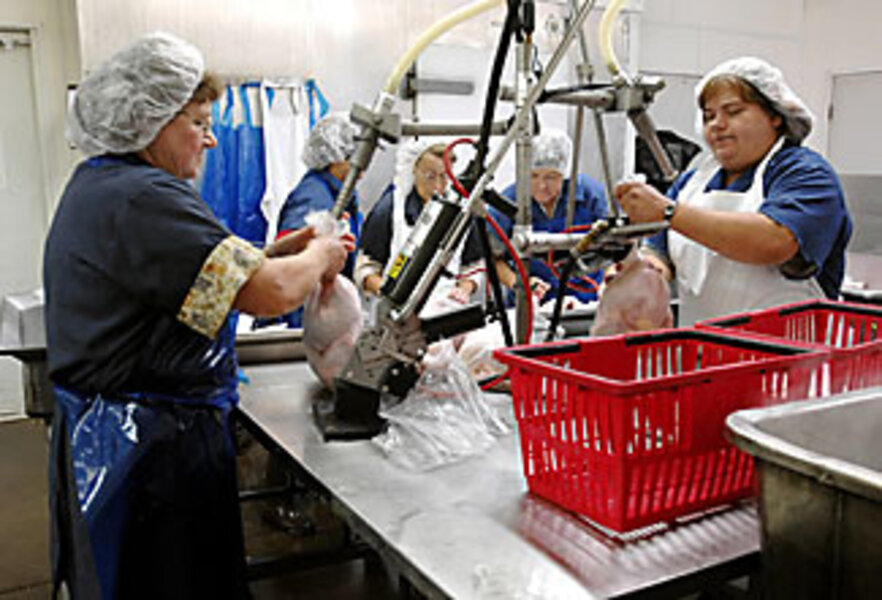End near for U.S.-E.U. chicken flap?
Loading...
| Atlanta
After years of sniping over cosmetics, clementines, and biofuel, an unlikely ambassador has emerged in the transatlantic trade wars between the United States and Europe: the barrel-chested American chicken.
A new European effort to lift an 11-year-old European Union ban on US poultry may become the first major victory of the Transatlantic Economic Council (TEC), which was created last year to put political pressure on grudge-holding bureaucrats on both sides of the pond. Loosening restrictions on the lowly clucker, experts say, could help ease a number of recent trade flaps, which overall could result in as much as 3.5 percent GDP growth for both blocs, according to the Organisation for Economic Co-operation and Development in Paris. On Wednesday, the European Commission is expected to hear a proposal by its health chief to open Europe back up to American chicken farmers.
But from the massive poultry farms of Georgia to the charcuteries of France, the chicken-ban issue is not just about agricultural protectionism in Europe, but also about culinary animosity between the Yanks and especially the French. It pits plumped-up US "factory chicken" against the subsidized range-feeding practices that go into growing the arguably skinnier, and arguably tastier, European bird.
"There's no way any citizen of France is sitting there going, 'I wish I had American chicken,' " says Tim Young, who raises chickens the French way on his farm in Elberton, Ga. "Our chicken is not that good."
It wasn't taste, however, that turned the Europeans off from US poultry in 1997. At issue was the US method of safeguarding chicken from bacteria: a diluted chlorine wash that has been used in US production since 1980. The ban was part of a European resistance toward genetically altered and chemically treated food.
Cutting through local passions over food and how it's handled is a tough first-rounder for the TEC. In fact, 20 of the EU's 27 member countries showed serious reservations about accepting the US poultry production model during a bloc meeting of agriculture ministers last week. "The Americans can do what they like, but we will do what we want," French Agriculture Minister Michel Barnier told Reuters.
If EU member countries can be persuaded to lift the ban, however, it could resolve long-standing disputes over everything from lipstick to biodiesel, experts say.
"TEC is supposed to promote transatlantic economic integration, remove unnecessary impediments to trade, and – to the extent possible – align our regulatory processes to avoid unnecessary friction," says Daniel Price, assistant to the president for international affairs and the US co-chair of the TEC. "A successful resolution of this issue is an important test of TEC's ability to deliver real results for the transatlantic economy."
The TEC has already addressed divergent accounting standards that had logjammed transatlantic trade for years, says Mr. Price. But that was a mundane debate compared to the chicken conundrum, where European politicians are having to stand up to powerful agricultural interests and continental condescension about American food practices.
"It used to be thought that it would be easier to get experts to agree on a common solution, but often it's harder to get experts to compromise, because they feel their way of analyzing the problem is the scientifically correct way," says Alberta Sbragia, an EU expert at the University of Pittsburgh. "Europe is now a powerful enough economic actor that they think the way they do things is best – and the US thinks what they do is best."
Yet there is growing pressure for European leaders to override the bloc's regulators and ease up on American farmers, experts say. Ultimately at stake, they add, is Europe's ability to compete against the stalwart American economy as well as the blossoming markets of Asia.
"At the highest political level at the EU – and we'll see whether it's critical mass – there are a number of politicians who recognize that the US and the EU are two of the largest trading blocs in the world. And to have these kinds of issues continue to fester and remain unsolved doesn't seem to be a situation that people at the political level should continue to tolerate," says Bill Roenigk, chief economist at the National Chicken Council in Washington.
This barnyard standoff has dragged on for much longer than most people predicted. But a few new revelations have changed the dynamics. Despite the EU listing chlorine as a carcinogen, two EU studies have found no risk to human health from eating poultry washed with a chlorine solution, according to Mr. Roenigk. And when the Financial Times recently reported that France was using a similar chlorine wash for chicken exports to Saudi Arabia, the EU may have lost a patch of high ground.
If the ban is lifted, the effect on the $2 billion US poultry trade would be modest at first, experts say: Exports of primarily white breast meat to the EU could rise to as high as $180 million per year. American poultry proponents predict that many European consumers, especially those who can't afford the pricier European bird, will buy American chicken breast.
"I still think that the flavor of the chicken has more to do with the chef than the way it is grown or the breed," says Mike Lacy, chair of the poultry science department at the University of Georgia in Athens.





